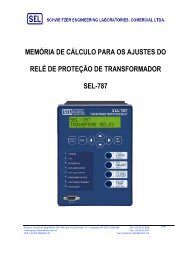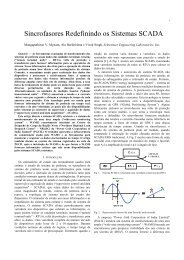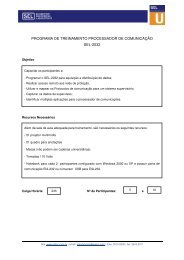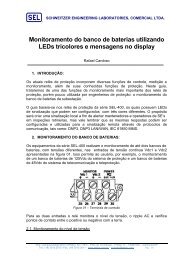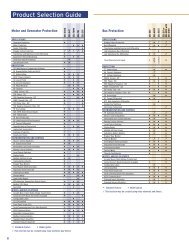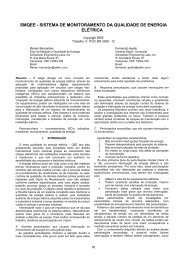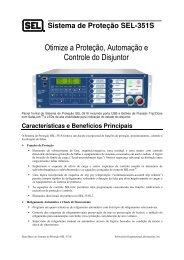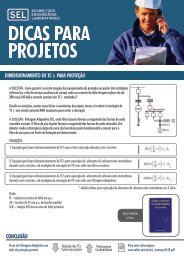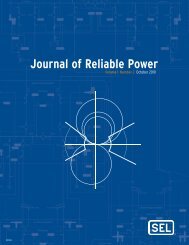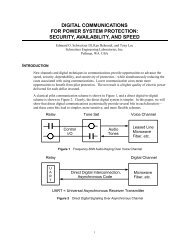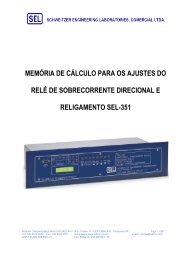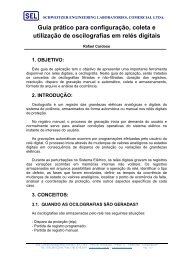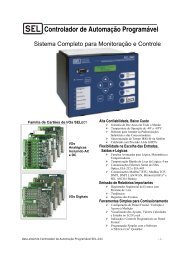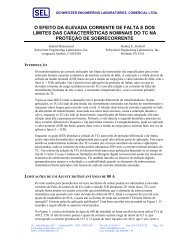Journal of Reliable Power - SEL
Journal of Reliable Power - SEL
Journal of Reliable Power - SEL
You also want an ePaper? Increase the reach of your titles
YUMPU automatically turns print PDFs into web optimized ePapers that Google loves.
13<br />
XIII. CONCLUSIONS<br />
• Evolving faults can challenge fault location and<br />
targeting algorithms; <strong>of</strong>fline tools can improve fault<br />
location accuracy.<br />
• Evolving faults can delay distance element tripping;<br />
common zone timing allows faster fault clearing.<br />
• Evolving faults can create reclosing problems; use trip<br />
elements to initiate reclosing and nonreclosing elements<br />
in drive-to-lockout logic.<br />
• Carrier holes cause DCB scheme problems; BT<br />
extension logic adds security.<br />
• Sensitivities <strong>of</strong> local and remote line relays should be<br />
matched.<br />
• Commissioning tests should concentrate on proving the<br />
overall protection system.<br />
• Unique event reports should be archived as<br />
COMTRADE files and used to test new schemes.<br />
• CVT transients can cause Zone 1 overreach; CVT<br />
transient detection logic adds security.<br />
• Extend reclosing open intervals beyond CVT transient<br />
response and set fault detectors above inrush on lines<br />
with tapped loads.<br />
• Older LOP logic relied on fault detectors set above<br />
normal load currents; improved LOP logic operates<br />
faster and is less dependent on fault detector settings<br />
for security.<br />
• Relays that include multiple polarization schemes and<br />
choose the appropriate element for the system and fault<br />
<strong>of</strong>fer the best sensitivity and security.<br />
• Do not apply standard settings blindly; directional<br />
element performance is critical and should be checked,<br />
especially for extreme conditions.<br />
• Set carrier extension pickup delay to zero in DCB<br />
schemes.<br />
• Missing or multiple ground wires in instrument<br />
transformer circuits cause directional element<br />
misoperations; thorough commissioning tests and<br />
automated meter data comparisons should find these<br />
errors before misoperations occur.<br />
[4] G. Alexander, K. Zimmerman, and J. Mooney, “Setting the <strong>SEL</strong>-421<br />
Relay With Sub-Cycle Elements in a Directional Comparison Blocking<br />
Scheme,” Schweitzer Engineering Laboratories, Inc. Application Guide<br />
2007-10. [Online] Available: http://www.selinc.com/aglist.htm.<br />
[5] A. Guzman, J. Roberts, and K. Zimmerman, “Applying the <strong>SEL</strong>-321<br />
Relay to Permissive Overreaching Transfer Trip (POTT) Schemes,”<br />
Schweitzer Engineering Laboratories, Inc. Application Guide 95-29.<br />
[Online] Available: http://www.selinc.com/aglist.htm.<br />
[6] J. Roberts, E. O. Schweitzer III, R. Arora, and E. Poggi, “Limits to the<br />
Sensitivity <strong>of</strong> Ground Directional and Distance Protection,” presented at<br />
the 1997 Spring Meeting <strong>of</strong> the Pennsylvania Electric Association Relay<br />
Committee. [Online] Available: http://www.selinc.com/techpprs.htm.<br />
[7] D. Hou and J. Roberts, “Capacitive Voltage Transformers: Transient<br />
Overreach Concerns and Solutions for Distance Relaying,” presented at<br />
the 22nd Annual Western Protective Relay Conference in Spokane, WA,<br />
October 1995. [Online] Available: http://www.selinc.com/techpprs.htm.<br />
[8] J. Mooney and S. Samineni, “Distance Relay Response to Transformer<br />
Energization: Problems and Solutions,” presented at the Texas A&M<br />
Conference for Protective Relay Engineers, College Station, TX,<br />
March 2007. [Online] Available: http://www.selinc.com/techpprs.htm.<br />
[9] <strong>SEL</strong>-321 Instruction Manual, Schweitzer Engineering Laboratories, Inc.,<br />
Pullman, WA.<br />
[Online] Available: http://www.selinc.com/instruction_manual.htm.<br />
[10] <strong>SEL</strong>-221G5 Instruction Manual, Schweitzer Engineering Laboratories,<br />
Inc., Pullman, WA.<br />
[Online] Available: http://www.selinc.com/instruction_manual.htm.<br />
[11] J. Roberts and R. Folkers, “Improvements to the Loss-<strong>of</strong>-Potential<br />
(LOP) Function in the <strong>SEL</strong>-321,” Schweitzer Engineering Laboratories,<br />
Inc. Application Guide 2000-05.<br />
[Online] Available: http://www.selinc.com/aglist.htm.<br />
[12] K. Zimmerman, “Negative-Sequence Directional Element Revisited,”<br />
presented at the 21st Annual <strong>SEL</strong> Technical Seminar at the Western<br />
Protective Relay Conference in Spokane, WA, October 2005.<br />
[13] G. Alexander, K. Zimmerman, and J. Mooney, Schweitzer Engineering<br />
Laboratories, Inc. Application Guide 2007-10.<br />
[Online] Available: http://www.selinc.com/aglist.htm.<br />
XVI. BIOGRAPHY<br />
David Costello graduated from Texas A&M University in 1991 with a BSEE.<br />
He worked as a system protection engineer at Central <strong>Power</strong> and Light and<br />
Central and Southwest Services in Texas and Oklahoma. He has served on the<br />
System Protection Task Force for ERCOT. In 1996, David joined Schweitzer<br />
Engineering Laboratories, Inc., where he has served as a field application<br />
engineer and regional service manager. He presently holds the title <strong>of</strong> senior<br />
application engineer and works in Boerne, Texas. He is a senior member <strong>of</strong><br />
IEEE, and a member <strong>of</strong> the planning committee for the Conference for<br />
Protective Relay Engineers at Texas A&M University.<br />
XIV. ACKNOWLEDGMENT<br />
The author gratefully acknowledges Normann Fischer,<br />
Karl Zimmerman, Bill Fleming, Joe Mooney, and Matt Leoni<br />
for their contributions to the original event analyses.<br />
XV. REFERENCES<br />
[1] <strong>SEL</strong>-311B Instruction Manual, Schweitzer Engineering Laboratories,<br />
Inc., Pullman, WA.<br />
[Online] Available: http://www.selinc.com/instruction_manual.htm.<br />
[2] K. Zimmerman and D. Costello, “Impedance-Based Fault Location<br />
Experience,” presented at the 31st Annual Western Protective Relay<br />
Conference in Spokane, WA, October 2004.<br />
[Online] Available: http://www.selinc.com/techpprs.htm.<br />
[3] <strong>SEL</strong>-311C Instruction Manual, Schweitzer Engineering Laboratories,<br />
Inc., Pullman, WA.<br />
[Online] Available: http://www.selinc.com/instruction_manual.htm.<br />
© 2007 Schweitzer Engineering Laboratories, Inc.<br />
All rights reserved.<br />
20070913 • TP6280-01<br />
64 | <strong>Journal</strong> <strong>of</strong> <strong>Reliable</strong> <strong>Power</strong>



